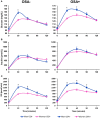Sex Differences in the Impact of Obstructive Sleep Apnea on Glucose Metabolism
- PMID: 30042734
- PMCID: PMC6048262
- DOI: 10.3389/fendo.2018.00376
Sex Differences in the Impact of Obstructive Sleep Apnea on Glucose Metabolism
Abstract
Objectives: Obstructive sleep apnea (OSA) is more prevalent in men and is an independent risk factor for type 2 diabetes. We aimed to determine if there are sex differences in the impact of OSA on glucose metabolism in nondiabetic overweight and obese adults. Methods: One hundred and forty-five men and women (age 33.4 ± 0.6, BMI 37.2 ± 0.7, 70.3% blacks) from the community underwent in-laboratory polysomnography. Severity of OSA was assessed by the apnea-hypopnea index (AHI). Glucose tolerance was assessed using fasting glucose, 1-h glucose, 2-h glucose and the area under the curve (AUC) during the 2-h oral glucose tolerance test (OGTT). Fasting insulin resistance was assessed by HOMA-IR, and insulin sensitivity during the OGTT was assessed by the Matsuda Index. Pancreatic beta-cell function was assessed by fasting HOMA-%B and by AUCinsulin/glucose, insulinogenic index, and oral disposition index (DIoral) during the OGTT. All comparisons were adjusted for age, BMI, race and severity of OSA. Results: There were no significant demographic differences between men and women without OSA. Men and women with OSA were similar in age, BMI, and severity of OSA, but there were more black women with OSA. Compared to women with OSA, men with OSA had significantly higher fasting glucose, 1-h glucose levels, AUCglucose, and AUC for insulin secretion rate (AUCISR) but similar 2-h glucose levels. These differences persisted in adjusted analyses. Men with OSA secreted significantly more insulin than women with OSA in order to achieve similar glucose levels. Men with OSA had significantly worse beta cell function as measured by the DIoral than women with OSA. In contrast, there were no significant sex differences in measures of glucose tolerance and beta-cell function in participants without OSA. Conclusion: Men with OSA secreted more insulin compared to women with OSA in order to maintain glucose homeostasis. The adverse impact of OSA on beta-cell responsiveness was larger in men, which may result in an overall greater risk of type 2 diabetes compared to women.
Keywords: beta-cell; diabetes; gender; glucose tolerance; insulin resistance; obstructive sleep apnea; sex; sleep-disordered breathing.
Figures

References
-
- National diabetes statistics report 2017 U.S. Department of Health and Human Services. Centers for Disease Control and Prevention (2017). Available online at: https://www.CDC.Gov/diabetes/pdfs/data/statistics/national-diabetes-stat... (Accessed February 1, 2018).
Grants and funding
LinkOut - more resources
Full Text Sources
Other Literature Sources

